Top speed 140 km/h Length 13 m First flight 1917 | Wingspan 30 m Introduced 1918 | |
 | ||
Minecraft wwi aircraft caproni ca 4 bomber tutorial
The Caproni Ca.4 was an Italian heavy bomber of the World War I era.
Contents
Development
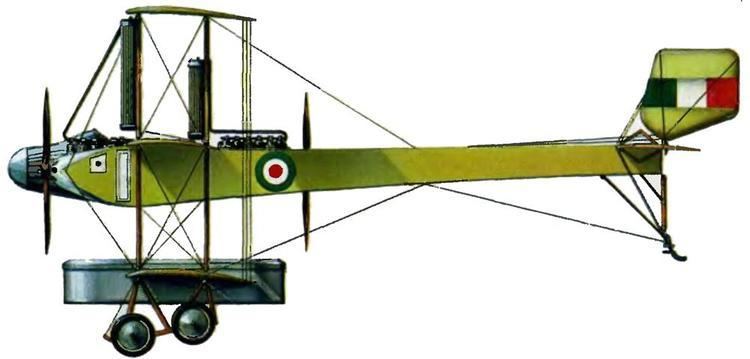
After designing the successful Ca.3, Gianni Caproni of the Caproni works designed a much bigger aircraft. It shared the unusual layout of the Caproni Ca.3, being a twin-boom aircraft with one pusher engine at the rear of a central nacelle and two tractor engines in front of twin booms, providing a push-pull configuration. The twin booms carried a single elevator and three fins. The main landing gear was fixed and consisted of two sets of four wheels each. The most distinguishing feature of the new aircraft was that it was built in a rare triplane layout, instead of the more common biplane.
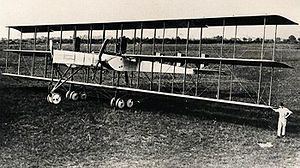
The huge new bomber was accepted by the Italian Army under the military designation Ca.4, but it was produced in several variants, differing in factory designations.
Description
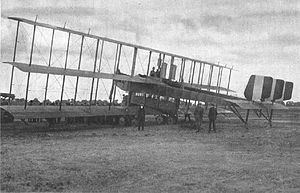
The Ca.4 was a three-engine, twin-fuselage triplane of wooden construction with a fabric-covered frame. An open central nacelle was attached to the undersurface of the center wing. It contained a single pusher engine, pilot, and forward gunner. The remaining engines were tractor mounted at the front of each fuselage. At least one variation of the central nacelle seated the crew in a two-seat tandem format with the forward position for a gunner/pilot and the rear position for the pilot. Others used a forward gunner with side-by-side pilot positions to the rear of the gunner. Two rear gunners were positioned, one in each boom behind the center wing. An engineer or second pilot could also be accommodated there.
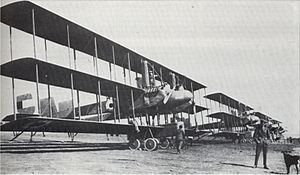
Armament consisted of four (but up to eight) Revelli 6.5 mm or 7.7 mm machine guns in front ring mounts and two boom ring mounts. Bombs were suspended in a bomb bay, which was a long and narrow container fixed to a lower wing. Photographs show at least four different arrangements with regard to the bombing nacelle.
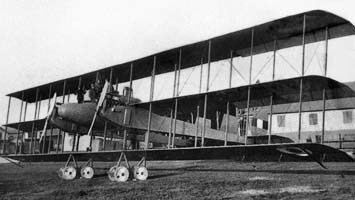
Variants
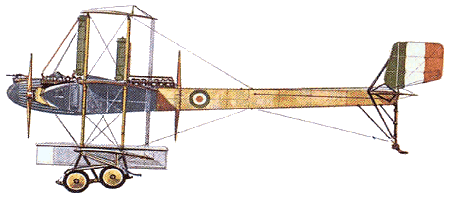
Note: during the war, all these aircraft were designated Ca.4 by the Italian Army. At the time, Caproni referred to the various designs by the total power of their engines. After the war, Caproni devised a new designation scheme for their own designs—these are used below.
Production figures differ in publications. The most likely number is 38 of all Ca.4 variants (other quoted figures are: 38 of Ca.40 and Ca.41 and 6 Ca.42 or 32 Ca.42 and 21 of other variants). Numerous publications incorrectly refer to all variants as the Ca.42.
Operational history
Ca.4s were tested by the Italian Air Force in 1917 and began operations in 1918. They were used for attacking targets in Austria-Hungary. In April 1918, six Ca.42s were issued to the British RNAS (No. 227 Sqn) but were never used operationally and were returned to Italy after the war. At least three CA.42s were sent to the United States for evaluation. After the war, the Ca. 4 was replaced in Italy by the Ca.36.
Despite its unstable and fragile appearance, the Ca.4 was well designed. Its size, without regard to its height, was not any larger than that of other foreign heavy bombers. With Liberty engines, it had a fast speed, similar to other heavy bombers, while its bombload had one of the largest capacities of that era, surpassed only by that of the Imperial German: Zeppelin-Staaken R.VI. If it had been flown with other engines, its performance would have suffered.
On 2 August 1919, after its wings apparently collapsed in mid-flight at an altitude of 3,000 feet (912 meters), a Ca.48 airliner crashed at Verona, Italy, during a flight from Venice to Taliedo, Milan. All on board died. It was Italy's first commercial aviation disaster and one of the earliest heavier-than-air airliner disasters.
Operators
Specifications (Ca.42)
General characteristics
Performance
Armament
